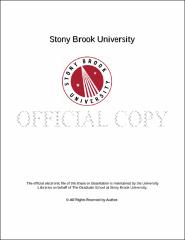| dc.identifier.uri | http://hdl.handle.net/11401/76644 | |
| dc.description.sponsorship | This work is sponsored by the Stony Brook University Graduate School in compliance with the requirements for completion of degree. | en_US |
| dc.format | Monograph | |
| dc.format.medium | Electronic Resource | en_US |
| dc.language.iso | en_US | |
| dc.publisher | The Graduate School, Stony Brook University: Stony Brook, NY. | |
| dc.type | Dissertation | |
| dcterms.abstract | The classic model of type Ia supernovae still taught in many textbooks describes a white dwarf primarily composed of carbon and oxygen accreting from a companion until it nears the critical Chandrasekhar mass, contracts, ignites carbon fusion and explodes. The research community, however, is seeing whatever consensus that may have existed on this model as the dominant channel to normal type Ia’s erode in the face of both observational and theoretical challenges. In my dissertation I present the largest ever suite of three-dimensional models of an alternative type Ia progenitor model: the double detonation model. This model evades the requirement for a near-Chandrasekhar mass white dwarf, making it much easier to satisfy observational and theoretical constraints. The sub-Chandrasekhar systems I investigate are also relevant to a variety of other possible explosive outcomes such as helium novae, ".Ia" events, atypical/sub-luminous type Ia’s, and shell deflagrations. I have deployed and further developed the low Mach number astrophysical fluid dynamics code Maestro to carry out my study. Most saliently, I have developed Maestro's nuclear reaction modules to target GPU accelerators in leadership supercomputers. I find that the double-detonation model is promising and warrants continued study by providing the broadest and most detailed characterization to date of the pre-explosive three-dimensional evolution. I also comment on what my models suggest about other explosive possibilities. | |
| dcterms.abstract | The classic model of type Ia supernovae still taught in many textbooks describes a white dwarf primarily composed of carbon and oxygen accreting from a companion until it nears the critical Chandrasekhar mass, contracts, ignites carbon fusion and explodes. The research community, however, is seeing whatever consensus that may have existed on this model as the dominant channel to normal type Ia’s erode in the face of both observational and theoretical challenges. In my dissertation I present the largest ever suite of three-dimensional models of an alternative type Ia progenitor model: the double detonation model. This model evades the requirement for a near-Chandrasekhar mass white dwarf, making it much easier to satisfy observational and theoretical constraints. The sub-Chandrasekhar systems I investigate are also relevant to a variety of other possible explosive outcomes such as helium novae, ".Ia" events, atypical/sub-luminous type Ia’s, and shell deflagrations. I have deployed and further developed the low Mach number astrophysical fluid dynamics code Maestro to carry out my study. Most saliently, I have developed Maestro's nuclear reaction modules to target GPU accelerators in leadership supercomputers. I find that the double-detonation model is promising and warrants continued study by providing the broadest and most detailed characterization to date of the pre-explosive three-dimensional evolution. I also comment on what my models suggest about other explosive possibilities. | |
| dcterms.available | 2017-09-20T16:50:52Z | |
| dcterms.contributor | Zingale, Michael | en_US |
| dcterms.contributor | Walter, Frederick M | en_US |
| dcterms.contributor | Fernandez-Serra, Marivi | en_US |
| dcterms.contributor | MacFadyen, Andrew. | en_US |
| dcterms.creator | Jacobs, Adam Michael | |
| dcterms.dateAccepted | 2017-09-20T16:50:52Z | |
| dcterms.dateSubmitted | 2017-09-20T16:50:52Z | |
| dcterms.description | Department of Physics | en_US |
| dcterms.extent | 86 pg. | en_US |
| dcterms.format | Application/PDF | en_US |
| dcterms.format | Monograph | |
| dcterms.identifier | http://hdl.handle.net/11401/76644 | |
| dcterms.issued | 2016-12-01 | |
| dcterms.language | en_US | |
| dcterms.provenance | Made available in DSpace on 2017-09-20T16:50:52Z (GMT). No. of bitstreams: 1
Jacobs_grad.sunysb_0771E_13047.pdf: 9522747 bytes, checksum: b8d8d2185b6c23ccb55a54e928773087 (MD5)
Previous issue date: 1 | en |
| dcterms.publisher | The Graduate School, Stony Brook University: Stony Brook, NY. | |
| dcterms.subject | Astrophysics -- Physics | |
| dcterms.title | The Explosive Possibilities of Little Dwarfs: Low-Mach Number Modeling of Thin Helium Shells on Sub-Chandrasekhar Mass White Dwarfs | |
| dcterms.type | Dissertation | |

